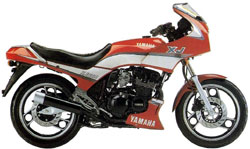Back to Yamaha Reliable Used Motorcycle Buyers Guide Index Page
Manufacturer: Yamaha……..TOP Model: XJ600, YX600 Radian, FJ600
Years Made: 1984 – 1990 Style: Sport Standard (Seca/Radian) Engine Type:
598cc Inline-Four
mm/ “Weight: 460lb HP: 72 Torque: Top Speed: 130mph MPG: 50 New Cost: New Cost: o $3,599 (1984) – $3,599 (1985) – $3,599 (1988)
Average Used Costs: Low $924 Medium $1,239 High $1,765
Description:
In the history of motorcycling, THE YAMAHA FJ600 SERIES deserve a few lines – not for being such a fabulous bike – because they really are little more than a competent UJM – but rather for being the first Japanese in-line 4 with a 600cc capacity. From this bike, came the 600 super-sports of today.
Back in the 1983, there were no 600s. Lots of 550s though, such as the Yamaha XJ550, the Honda CBX550, the Suzuki GSX550 (in various forms) and the Kawasaki GPz550. All of these bikes had essentially grown out of 500s, or in response to another Japanese manufacturer putting out a 550. Then in 1984 Yamaha released its XJ600. (The same bike was released in the USA in 1984 as the FJ600.)
The XJ600 was a refinement of the previous XJ550 – a 2 valve, air cooled engine with chain drive. The engine was narrow as the designers had put the alternator behind the motor. The XJ600 was one of Yamahas first 4 cylinder bikes to run a mono shock rear suspension design. I think the FJ1100 was the first – it was released in Australia in 1983.
Kawasaki was the first to respond, with its more powerful (but much more sports focused) water cooled GPZ600R in 1985. Honda’s CBR600 was not released until about 1988 The CBR600 was substantially more powerful than any other 600 at that time. Suzuki and Yamaha also released their 600 sporties – the GSXR and FZR in the late 1980s into a market place that embraced their products keenly. The 600 super sports had really arrived…
But it was the XJ600 that started it all. It’s really a sports -tourer, so it does not inflict some of the physical compromises that later 600s do on their riders. In 1984 it was faster than any other 550 on the road, and gave most Japanese 750s a solid run for their money. Indeed for about 9 months it the fastest thing under 750cc – until the GPZ600R was released. It design has aged well, as it was essentially re-released in 1993 as the XJ600 Diversion (or Seca, depending on which market your from.)
Notes:
UMG Says: Useful, fast multi with few hidden vices. Wheel bearings only last for 20k. After 50k watch out for worn cams, naff gearboxes, slipping clutches and an electrical system with a deathwish. The odd one has done over 100k but most of them were out of action by 70 thou. Rot can rapidly overwhelm the chassis. The USA had the more custom Radian version, available as a grey import.
IGM Says (FJ600): Although considered a sportbike in its day, the FJ seems like a standard today. With its frame-mounted half-fairings and sporty riding position, this bike is still striking today. If you can find a clean example of this elegant bike, buy it.
IGM Says (YX600 Radian): The successor to the FJ600 had all that bike’s mechanical virtues but lacked the FJ’s style. It’s still a good bike, though.
CMB Says (YX600 Radian): The Radian 600 was constructed from parts bins at Yamaha. Their idea was to make a technologically competent motorcycle at an entry level price. The YX600 did the job marvelously. This is a fun, all purpose bike that is great in city traffic. It lacks a lot of the raked out, chromed up sizzle of other bikes, but with a very well established engine and parts, the bike has staying power for a used bike buyer. Look for its predecessors. the FZ600 and FJ600.

